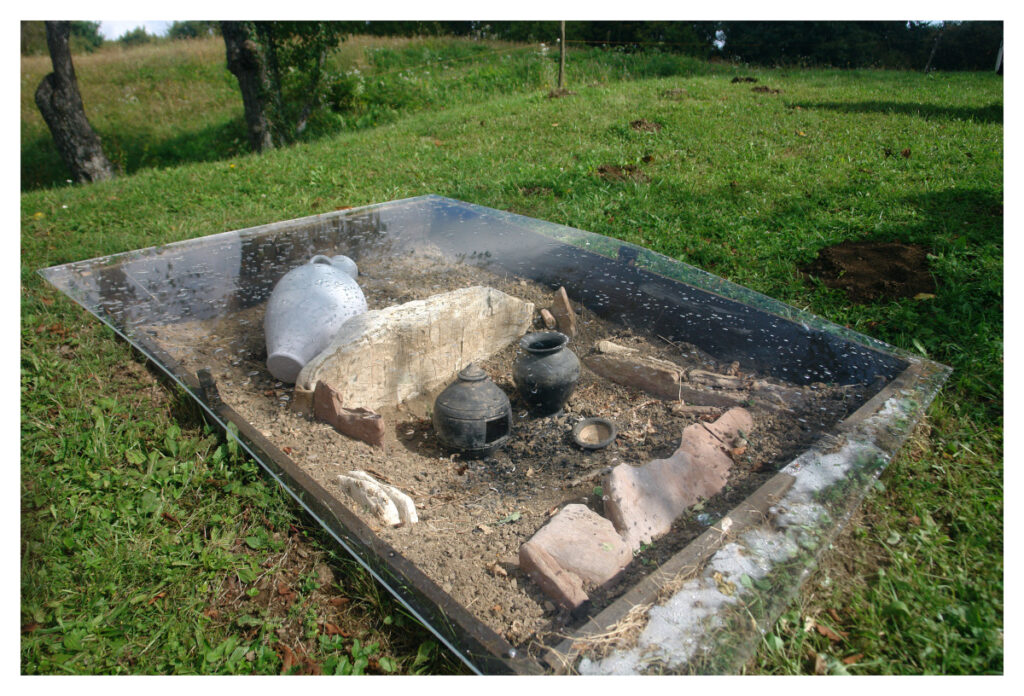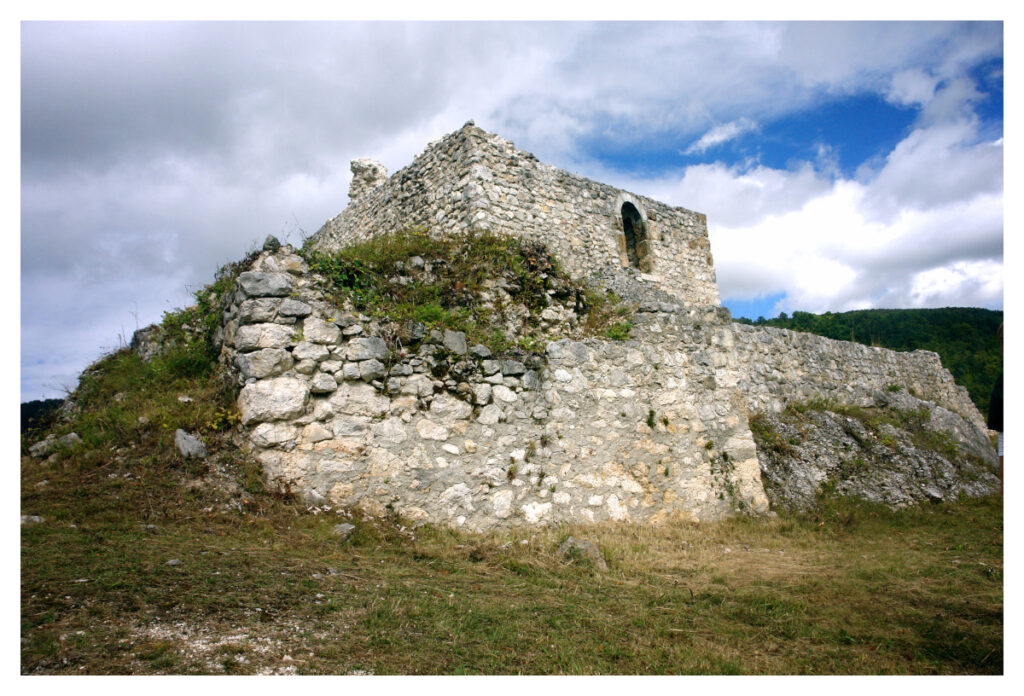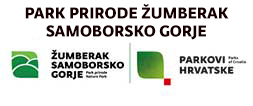HISTORY – AND BEFORE
NEW STONE AGE OR NEOLITHIC
When was it? Around 6 000 – 3 000 BC
The last and youngest period of the Stone Age was named after blending two Greek words – neos meaning new and lithos meaning stone. New stone or New Stone Age – what should it mean? In the Neolithic, like in other Stone Ages, people often used stone for making tools and weapons, but after hundred thousands of years they started to use the same material in a different way. While in Old and Middle Stone Ages they cut the stones, in the Neolithic they mastered new techniques of working with stones like scouring and polishing which enabled production of finer tools.
What remains from the Neolithic are found in Žumberak?
Considerate examples of stone axes are found not during archaeological excavations, but completely by chance and on different locations. They are mostly made of andezite or serpentinite (solid volcanic rocks). There are two different types of axes – some are flat and trapezoid, while others look like a hammer and have a hole in the body for setting on a handle. Flat axes, which were bound to handles, were made earlier but also at the time when the ones with holes already existed so it is hard to decipher which were newer among those found in Žumberak. These axes document the process of populating Žumberak and the Samoborsko gorje in the New Stone Age. This tool was frequently used for cutting woods which meant the creation of grassland surfaces essential for raising cattle and cultivating plants for food.
Where can you see the finds?
Original axes are kept in Samobor town museum.
In the exhibition in Eco-centre Budinjak you can see the illustration of their usage.
COPPER AGE OR ENEOLITHIC
When was it? Around 3 500 – 2 200 BC
Words from even two languages are borrowed to compound a new one which describes the Copper Age. Latin word aeneus meaning bronze and Greek word lithos meaning stone are compounded together (bronze stone or bronze-stone age) and do not make sense, but only by appearance. Well, how are bronze and stone connected with copper?
First blacksmiths in the history of mankind started developing metallurgy not before the Eneolithic. Copper processed by forging and casting in moulds started more regularly replacing stone as the material for making tools and weapons. Although the apparition of metal of which some rare items were made even in earlier period of the Neolithic, the Eneolithic was not the period of intense and deep social changes. Still, breeding cattle became dominant over agriculture and trade became more intense as breeding cattle quicker made surpluses. Accumulation of material wealth probably influenced on forming of tightly connected genial and tribal communities.
What remains from the Eneolithic are found in Žumberak?
Some fragments of ceramic containers are found during archaeological excavations in the vicinity of the church in Mrzlo Polje.
About a kilometer farther one inhabitant of the same village found a stone axe while plowing. Expert analysis of these items discovered their mutual origin. Ancient owners of these containers and an axe were the nomads who lived in the area of today northern Croatia in the age of the Eneolithic. They cultivated land, raised cattle and built small lodgings with lower parts dug in soil. We do not know their name, but according to the site of Lasinja on the river Kupa where the most significant traces of their life were found, the culture they made was named Lasinja culture. The items found in Mrzlo Polje are scarce, but obvious proof of their existence in this area. For now, we do not know how long people of Lasinja culture lived in this most beautiful field of central Žumberak.
Where can you see the finds?
Fragments of ceramic containers are kept on Archaeology Department in Philosophy Faculty in Zagreb.
The stone axe is in private ownership.
EARLY IRON AGE
When was it? 8th-5th century BC
The Early Iron Age started in wider area of south-east Europe at the turn of the 9th to 8th centuries BC. It is characteristic of implementation of iron which, as a completely new material, was used for tools, weapons and jewelry. Accelerated development of new metallurgy and trade empowered the economy of the Early Iron Age communities and the consequence was a huge gap in material status of their inhabitants. The highest class of military aristocracy dominated in increasingly stratified population. The most prominent representatives were called princes and their huge and opulently decorated tombs were found all over Europe. They are called tumuli (tumulus = a grave-mound with tombs which is the common example of burial architecture in the Early Iron Age in Europe).
What remains from the Early Iron Age are found in Žumberak?
The Early Iron Age settlement on the top of the hill and a graveyard with 140 tumuli at the foot of the settlement are preserved in Budinjak in central Žumberak. Because of considerate number of tumuli, this site is regarded as one of the biggest in the area of south-east Alps. Archaeological excavations started in 1984 and one fourth of the tombs have been excavated until the present day. Different items, metal weapons and jewelry were found there as well as numerous ceramic pots with food and drink for the deceased to have on the journey to the other world. Diversity of their shapes and decorations testify the richness of the inhabitants of Budinjak as well as mastery of craftsmen. Considerate number of items are shaped and decorated in typical manner of faraway lands like the Italian Peninsula, the Alps, the Danube basin and central Balkans. It is obvious that Budinjak was a settlement with powerful economy which enabled the contacts with faraway lands. In Budinjak graveyard two princes’ tumuli have been researched by now.
Each of them consisted of more tombs (in tumulus no. 3 there were ten tombs and in tumulus no. 139 seven tombs). In the middle of each tumulus there was the tomb of a prince. Bronze helmets were found in both of them – very precious and rare finds in Europe from the Early Iron Age. The diameter of circular tumulus no. 139 was 19 meters. In prince’s tomb there was a chamber (3 x 2 meters) for two people built of timber for two people – a man and a woman. Precious items were put next to the deceased – parts of their costumes, the man’s weapons, equipment for horses and pottery full of things necessary for journey to the other world. The most precious find in the grave was a bronze helmet worn by the prince of Budinjak as a symbol of power and respect. This helmet was named “Budinjak type” as a rare preserved example of helmets typical for the period.
Where can you see the finds?
The finds are kept in Zagreb city museum and Samobor museum.
A replica of the helmet, as well as replicas of several ceramic pots are exhibited in Eco-center Budinjak.
In the area of archaeological site Budinjak there is an archaeological park with educational Trail of Princes.
LATE IRON AGE
When was it? From 4th century BC to 1st century AD
The Late Iron Age is in our lands connected with a new ethnical element – the Celtic tribes which started conquering and colonizing a huge part of Europe from their domicile Central Europe to the south, east and west. By conquering new territories, they brought new culture – the most significant of which is their highly decorative style with ornaments primarily based on vegetal motifs and animal and human masks. In the north-west of Croatia the Celts did not appear before the 3rd century BC.
What remains from the Early Iron Age are found in Žumberak?
In the forest of Jama near Podgrađe at the foot of Okić a man from the village of Klaka found a jug with about 1 600 coins of silver money in 1922. It was coined by the Celts and is the oldest money found in this area. Their coins were the imitations of Greek money so on the front of each coin is the head of the Greek god Apolo, and on the tail is a horse. Because of the quantity of coins, it is supposed that one of Celtic mints was in Samobor. This is why these coins are called “Samobors”.
Where can you see the finds?
Some of “Samobors” are kept in Samobor museum and some are in Archaeological museum in Zagreb.
Enlarged photo of one of them can be seen in Eco-centre Budinjak.
ROMAN PERIOD OR ANCIENT TIMES
When was it?
1st century before Christ – 476 AD
Roman army general Octavian (later became the first Roman emperor, later also known as August) led the military campaign and conquered the area around the Sava 35 – 33 BC. Žumberak area became a part of one of the most powerful states in human history – the Roman Empire. Newly conquered areas were administratively divided into provinces, and Žumberak became the part of province of Panonia.
What remains from the Roman period are found in Žumberak?
Several graveyards dating from 1st century AD which were active until mid 2nd century were found in the central Žumberak in villages of Gornja Vas and Bratelji. Although it was a period of Roman administration formation, people buried in those graveyards ethnically belonged to the Celtic tribe of Latobics that had lived in neighboring Dolenjska on the territory of today’s Slovenia for centuries before Roman conquest. There have been 43 tombs preserved on the graveyard in Bratelji and 64 in Gornja Vas. They were partly destroyed due to centuries-long usage of the grassland where they were originally placed. The Latobics managed to preserve most of their ancient customs during Roman reign (for example, building tombs of stone plates or making unique pottery). Typical example is the urn shaped like a house that was sometimes topped by a decorative rooster. An exceptional example of urn in the shape of a house was found during excavations in Gornja Vas. Besides an opening symbolizing the door, it is decorated with carvings of armed men – the oldest known example of human figure in the area of Žumberak.
Despite keeping their own customs, the Latobics acquired the new Roman ones as well. Many glass containers excavated in Bratelji and Gornja Vas present something completely new in the material culture of the area. They are produced in big workshops specialized in glass-making in northern Italy and exported to decorate the tables of the richest Latobics.

Graveyard in Bratelj (part of the educationa trail The TRail of the Princes); Photo: Kristijan Solenički
Where can you see the finds?
The items found in Gornja Vas are exhibited in Samobor museum and in Archaeological museum in Zagreb.
The finds from Bratelji are kept in Archaeological museum in Zagreb.
MIDDLE AGES
When was it?
The period between 476 – 1498
After decline of the Roman Empire, numerous Germanic and later Slavic tribes passed across the Pannonian plain. Almost nothing is known about the great movement of the peoples and the period when the Croats came to Žumberak. The earliest written texts and archaeological finds enlighten the history of Žumberak from the 12th century on. It was the period when Žumberak was the border between two big feudal states – the Croatian-Hungarian Kingdom and the Germanic Empire.
What remains from the Middle Ages are found in Žumberak?
The remains of the material culture of the Middle Ages in Žumberak are today visible as ruins of fortified towns built at the end of the 12th or at the beginning of the 13th centuries. Among the most important are Tuščak and Lipovac, as well as Okić – the oldest fortified town in Croatia and Old Town of Žumberak, the central fortress in fortification system of this part of the frontier. It is situated deeply in the Žumberačko gorje on desolate 500-meter-high plateau. Historical documents mentioned it for the first time in 1249 as a property of Carinthian duke Majnhard. On the list of the parishes of Aquilean diocese from 1296 (Žumberak belonged to that ecclesiastical administrative unit at the period) Žumberak is mentioned as “Sicherberch” (old form of the word out of which word “Žumberak” derived). Old Town of Žumberak architecturally belongs to the category of fortified towns or “burgs” and consists of defensive tower, gate tower, fortified city walls and the church of St. Cross which was built outside city walls. At the beginning of the 14th century the noble family of Babonić took over the town. After that it became the property of Austrian dukes who governed over it until Ottoman rule and arrival of the Uskoks in the 16th century. At that period Old Town of Žumberak was deserted and in the vicinity, few kilometers to the east, a new fortress – New Town of Žumberak – was built as a part of the Croatian Military Border.

Old Town of Žumberak; Photo: Kristijan Solenički
Where can you see the finds?
The remains from Old Town of Žumberak are kept in Ministry of culture, Directorate for Cultural Heritage Protection and Conservation Department in Zagreb.

